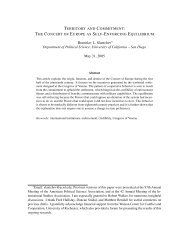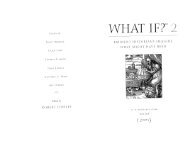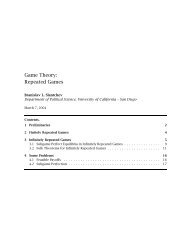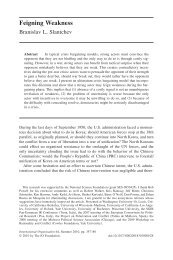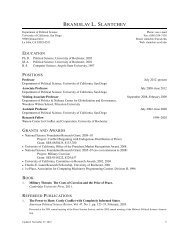Introduction to International Relations Lecture 10 - Branislav L ...
Introduction to International Relations Lecture 10 - Branislav L ...
Introduction to International Relations Lecture 10 - Branislav L ...
Create successful ePaper yourself
Turn your PDF publications into a flip-book with our unique Google optimized e-Paper software.
cessfully with the attackers s<strong>to</strong>rming the city, scaling the walls, and getting in.<br />
Most ended either with the withdrawal of the besieging army or the fall of the<br />
city due <strong>to</strong> either starvation or treachery. This is one of the fac<strong>to</strong>rs, by the way,<br />
that explains why feudalism <strong>to</strong>ok so long for kings <strong>to</strong> overcome: Once the local<br />
lord built his stronghold, it was virtually impossible <strong>to</strong> dislodge him. This also<br />
explains why one of the first things that kings did when they laid their hands on<br />
good siege equipment was <strong>to</strong> destroy the castles of their vassals, thereby concentrating<br />
all military power in their own hands. Defense seemed <strong>to</strong> dominate<br />
offense during the First World War <strong>to</strong>o, but new technology and tactics gave<br />
advantages <strong>to</strong> offense that the Germans made good use of in the Second.<br />
In addition <strong>to</strong> technology, geography can help alleviate some of the security<br />
dilemma. Belligerents can establish demilitarized zones — strips of land that<br />
are declared free of hostile armies (and sometimes patrolled by a third-party,<br />
like the United Nations). The idea is <strong>to</strong> separate the opponents, reduce the risks<br />
of surprise attack that each faces, and decrease the chances of incidents that<br />
might trigger reprisals and large-scale conflict. Such a demilitarized zone (DMZ)<br />
separates North Korea from South Korea <strong>to</strong>day. Another DMZ was established<br />
after the 1956 Suez War between Israel and Egypt when the Sinai peninsula<br />
was demilitarized and patrolled by U.N. forces right until Nasser asked them<br />
<strong>to</strong> leave on the eve of the Six Day War. Similarly, the Rhineland (the industrial<br />
heartland of Germany) was demilitarized after the First World War. Hitler’s<br />
first bold foreign policy stroke was <strong>to</strong> remilitarize it in 1936, six years after<br />
the withdrawal of the Allied occupation forces. When this went unopposed, he<br />
broadened his sights with results we all know well.<br />
Somewhat larger-scale geo-political formations with a similar role are the<br />
buffer zones. Like DMZs, these are areas that separate hostile forces but they<br />
need not be demilitarized. Very often, entire states provide buffer zones between<br />
potential belligerents. For example, when Napoleon was finally defeated<br />
by the Fourth Coalition in 1815, France was encircled with the cordon sanitaire,<br />
a collection of buffer states designed <strong>to</strong> box-in the restless country. It ran from<br />
Belgium in the North, through a chain of German states, and down <strong>to</strong> Italy. The<br />
architects of the Concert system who designed it at the Congress of Vienna were<br />
quite explicit about the role these states would play in containing future aggression<br />
by France. Along similar lines, Stalin demanded a buffer zone that would<br />
separate the Soviet Union from Germany in 1945. The Germans had invaded the<br />
country twice in the first half of the 20th century, and it was understandable<br />
that the Russians would be quite apprehensive about a possible repeat. Stalin<br />
wanted a barrier composed of neutral or pro-Russian states. The problem was<br />
that a non-communist East European state would quickly turn pro-Western and<br />
thus become less than neutral. It was not surprising, therefore, that Stalin began<br />
arranging for communist governments <strong>to</strong> take over in these countries. This is<br />
something Roosevelt seems <strong>to</strong> have unders<strong>to</strong>od far better than Truman did at<br />
the time.<br />
Another possibility is arms control. That is, an agreement <strong>to</strong> limit the arma-<br />
<strong>10</strong>




